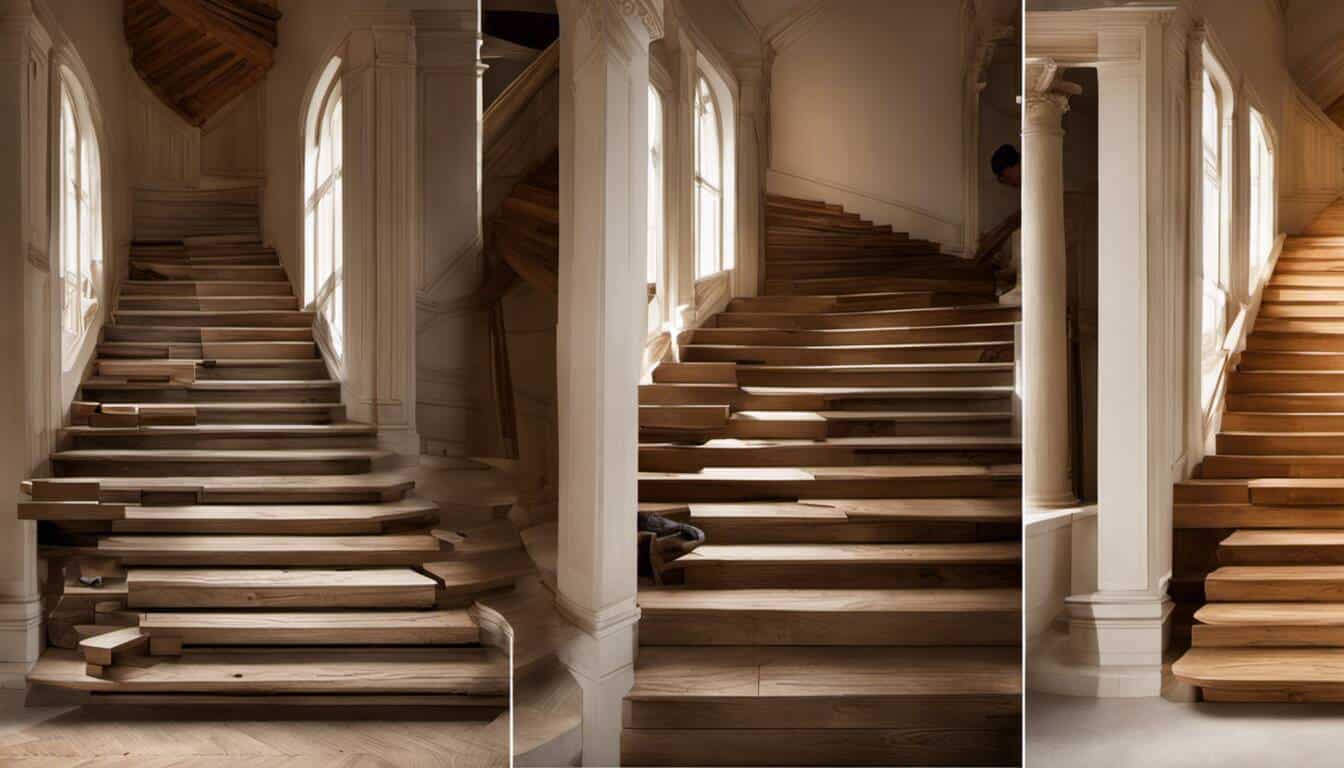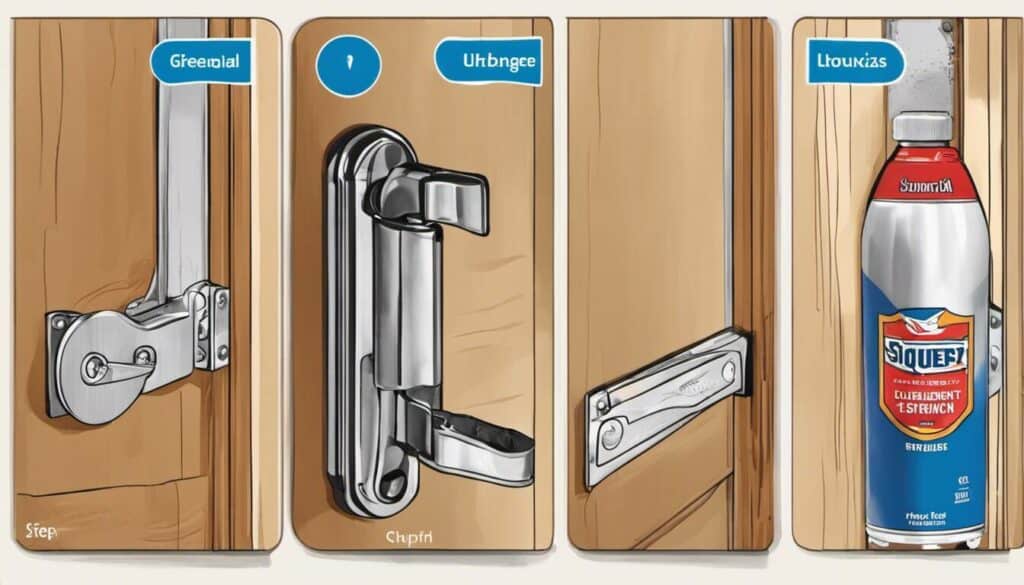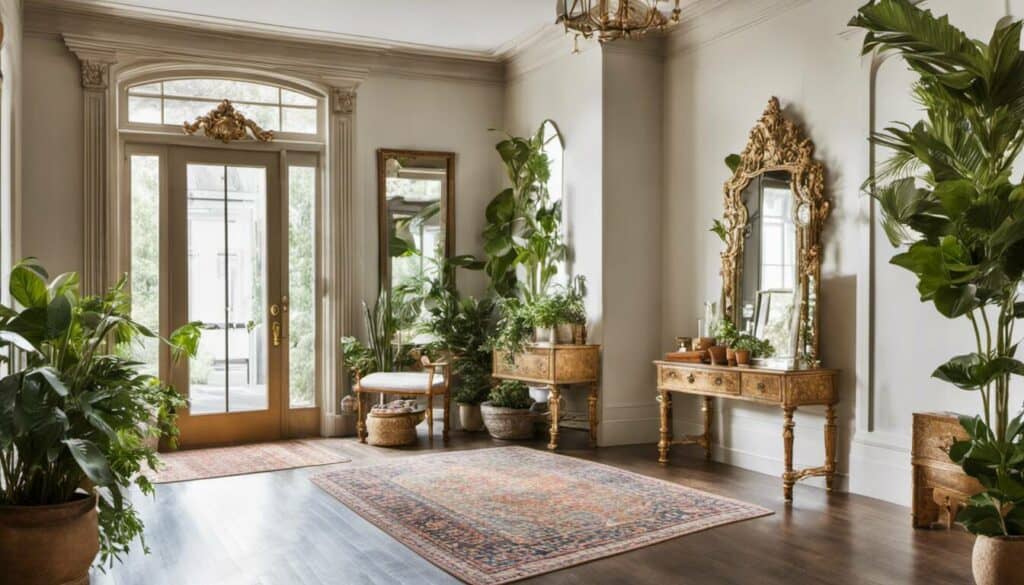In the fascinating world of home renovations, few transformations carry the awe-inspiring impact of a staircase metamorphosis. I learned this firsthand when I embarked on this transformation journey, completely unaware of the profound impact it would have on my home’s aesthetic. Through this blog post, I’ve detailed my evolution from the mundane to the magnificent—a comprehensive narrative chronicling the remarkable transformation of my staircase. Here is what I did, and what was learned during my journey.
“My Staircase: A Step-by-Step Tale” is an article on our website that details the renovation of a staircase from start to finish, including challenges faced during the project and the overall outcome. It provides readers with insights on a successful renovation project, which includes staining alternate stairs to allow foot traffic while still being worked on, planning for future home projects such as new flooring, and completing a first-time renovation job with excellent results.
“The key to transforming your staircase is to view it not merely as a functional construction but as a canvas for your personal expression. Keep in mind the staircase’s integration with overall house design and it’s potential to become a focal point. With a blend of right material, color, and lighting, you can make your staircase a central piece of your home’s design narrative.”
Gilbert Dreyfus, Master Architect, Interior Designer
Planning the Staircase Transformation
Before embarking on any home renovation project, careful planning is crucial to ensure a smooth and successful transformation. The same applies to the staircase renovation project. So, how does one go about planning a staircase transformation?
First and foremost, it’s important to determine the desired outcome of the renovation. Consider factors such as functionality, aesthetics, and budget. Are you looking to update the staircase for purely cosmetic reasons or do you also want to improve its structural integrity? Understanding your goals will help guide your decision-making throughout the process. For inspiration, you might want to check out some before and after entryway transformations to see how a well-executed staircase renovation can dramatically change the look of your home’s entrance.
Next, assess the current condition of your staircase. Are there any issues that need to be addressed, like loose handrails or damaged steps? Taking stock of these concerns will inform the necessary repairs or replacements during the transformation.
Considerations should also be made regarding safety regulations and building codes. Ensure that your planned design and construction align with these requirements to guarantee a safe and compliant final result.
Furthermore, it’s essential to establish a timeline for the project. Evaluate how much time you have available for renovations and plan accordingly. Keep in mind that unforeseen obstacles may arise and add extra time to the process, so buffering your schedule is advisable.
Finding Design Inspiration
Once you have a solid plan in place for your staircase transformation, it’s time to find design inspiration that aligns with your vision. This step is crucial as it sets the tone for the overall aesthetic of your staircase and helps bring your ideas to life.
Start by gathering inspiration from various sources such as interior design magazines, websites, social media platforms, or even visiting open houses or showrooms. Look for images or examples that resonate with your personal style and preferences. Pay attention to details like railing styles, materials used, and overall color schemes.
Additionally, consider the architectural style of your home when seeking inspiration. You’ll want your staircase design to complement the existing aesthetics rather than clash with them. Whether your home is modern, traditional, or somewhere in between, finding design inspiration that harmonizes with the overall vibe will create a cohesive and visually appealing result.
Remember, you don’t have to limit yourself to just one source of inspiration. Feel free to combine various elements and customize the design to suit your unique taste. The goal is to create a staircase that not only serves its functional purpose but also becomes a stunning focal point in your home.
- In a 2021 survey by Houzz, 40% of homeowners renovating their stairs considered it a major part of their home renovation project.
- According to the National Association of Home Builders, staircase renovations can increase a house’s value by up to 12%.
- A 2019 study in the Journal of Safety Research found that staircase accidents accounted for over 1 million emergency room visits per year in the United States.
Selecting Materials and Setting a Timeline
When embarking on a staircase transformation project, careful consideration must be given to selecting the right materials that align with your desired design and function. Whether you prefer the natural elegance of hardwood or the durability of composite materials, understanding their characteristics and properties is crucial. For instance, hardwood offers timeless beauty but may require more maintenance, while composites provide a low-maintenance option but may lack the authenticity of natural wood. By evaluating your priorities and conducting thorough research, you can make an informed decision that best suits your needs.
For my own staircase transformation, I chose to use oak for its warm and inviting aesthetic. Its versatility allowed me to customize the stain and finish to match my overall design concept. This not only added elegance to my home but also ensured durability for years to come. To further enhance the look, I considered adding crown molding to the staircase area, which can provide a polished and sophisticated touch to the overall design.
Furthermore, setting a timeline is essential to keep your project on track. Consider factors such as budget constraints, availability of materials, and the scale of the renovation when determining how long the transformation will take. It’s crucial to account for unexpected delays or unforeseen challenges that may arise during construction. By establishing a realistic timeline from the outset, you can effectively manage your expectations and ensure a smoother progression throughout the project.
- When undertaking a staircase transformation project, it is important to carefully choose the appropriate materials that match your desired design and functionality. Natural hardwood provides timeless elegance but may require more maintenance, while composite materials offer low-maintenance options with limited authenticity. Choosing a material that meets your needs while still aligning with your budget is essential. Setting a realistic timeline is also crucial to ensure completion within budget constraints and to account for unforeseen delays or complications that may arise during construction.
The Construction Process
Once you have selected the materials and set a timeline, it’s time to dive into the construction process itself. This phase involves a series of steps that bring your staircase transformation vision to life.
The first step is often demolition, where the existing staircase structure is carefully taken apart. This is followed by evaluating and repairing any underlying issues such as damaged framework or loose components.
Next comes the installation of the new staircase components. This includes assembling and attaching precut risers, treads, balusters, handrails, and newel posts according to your design specifications. For those looking to update their stairs on a budget, consider installing vinyl tile on the stairs as a cost-effective alternative that can still provide a stunning transformation.
Throughout this process, precise measurements are crucial in ensuring each component fits snugly together. Any necessary trimming or shaping may be required to achieve a seamless fit and professional finish.
Finally, the finishing touches are applied. Sanding down the wood surfaces, staining or painting as desired, and sealing with an appropriate protective coating all contribute to the overall aesthetic and longevity of your newly transformed staircase.
It’s important to note that undertaking such a construction project may require professional expertise, especially if it involves complex structural changes or building codes. Consulting with an experienced contractor or carpenter can ensure the success of your transformation while ensuring compliance with safety regulations.
Now that we have covered the basic steps involved in the construction process, let’s explore some key considerations to keep in mind during each stage.
Step-by-Step Staircase Building Guide
Building a staircase from scratch can be an exciting yet challenging endeavor. Let’s walk through the step-by-step process of constructing a stunning staircase that is not only functional but also adds aesthetic appeal to your home.
First and foremost, careful planning is essential. Start by measuring the available space and determining the desired dimensions for each step. Consider factors such as the rise (vertical height) and run (horizontal width) of each step to ensure comfort and safety.
Next, gather all the necessary materials and tools for the project. This may include lumber for the steps and framing, brackets or hangers for support, nails, screws, and a variety of hand and power tools.
The construction begins with building the stringers, the angled supports that hold up the treads and risers. Measure and cut the stringers according to your predetermined dimensions, ensuring precision to maintain consistent step height. Secure the stringers in place against a wall or framework using appropriate fasteners.
Once the stringers are secure, it’s time to add the treads – the horizontal boards on which you’ll actually step. Cut and install each tread, making sure they are snugly positioned against the stringers and properly attached using screws or nails.
After installing the treads, proceed to attach the risers – vertical boards that enclose the open space between each step. Again, measure and cut each riser accurately before securing them in place.
To enhance both safety and aesthetics, consider adding a decorative railing along one side of your staircase. Ensure it complies with local building codes regarding height and spacing between railings.
And voila! Your beautiful DIY staircase is complete. Remember to perform any necessary finishing touches such as sanding or staining to achieve the desired appearance.
Embarking on a staircase-building journey provides not only a sense of accomplishment but also an opportunity to customize an essential element of your home. Whether you choose a simple design or opt for intricate details, the end result will undoubtedly add character and functionality to your living space.
Post-Construction: The Finished Staircase
After months of meticulous planning and hard work, your staircase transformation is finally complete. Step back and admire the impressive outcome – a functional and visually appealing focal point of your home.
The finished staircase serves not only as a means to move between different levels but also as an expression of your unique style and taste. Its design can complement the overall aesthetic of your home or stand out as a statement piece.
Take a moment to appreciate the craftsmanship that went into every step and railing. The attention to detail, precise measurements, and careful selection of materials all contributed to the success of this project.
Moreover, the newly transformed staircase brings added value to your home. Potential buyers or guests will undoubtedly be impressed by the elegant focal point you’ve created. It’s a testament to both your creativity and commitment to enhancing your living space.
Remember, this staircase transformation is just the beginning. It opens up endless possibilities for further interior design projects, inspiring you to continue improving and remodeling other areas of your home. For instance, you might want to consider how to transition between two different wood floors to create a seamless flow from your newly renovated staircase to adjacent rooms.
Lessons Learned from the Staircase Transformation
The staircase transformation was not only a project that involved design and construction, but it also taught me valuable lessons along the way. One of the key takeaways was the importance of meticulous planning before diving into any renovation endeavor. It’s crucial to thoroughly research and visualize the desired outcome, considering factors like functionality, aesthetics, and budget.
In my case, I spent ample time browsing through various home decor websites and magazines, gathering inspiration for staircase designs that resonated with my personal style. By doing so, I was able to create a clear vision of what I wanted to achieve and make informed decisions about materials, colors, and finishes that would align with the overall theme of my home.
Moreover, the renovation project taught me the significance of adaptability. Despite careful planning, unforeseen challenges can arise during the process. For instance, while working on the stairs, we encountered unexpected structural concerns that required immediate attention and adjustment to our initial plans. It reminded me of the importance of flexibility and being prepared to address unforeseen issues as they arise.
Another lesson I learned is the significance of patience and perseverance throughout a renovation project. Renovations can be time-consuming and demanding, but keeping your focus on the end result will help you overcome any hurdles along the way.
It’s important to remember that even seasoned professionals encounter obstacles during home improvement projects. Whether it’s unexpected expenses or delays in obtaining materials, navigating these setbacks requires patience and determination. By embracing a positive mindset and staying committed to the goal, you can push through difficulties and achieve remarkable results.
Renovating a staircase is akin to climbing a mountain – challenging at times but immensely rewarding when you reach the summit. Just like slow and steady progress wins in mountaineering, taking measured steps during a renovation allows for precision and excellence in crafting your dream staircase.
Lastly, the staircase transformation taught me the value of seeking guidance and expertise when needed. While it’s tempting to take on DIY projects entirely on your own, professional advice can prove invaluable, particularly when dealing with complex structural or design aspects.
In my case, I enlisted the help of a skilled contractor who not only provided expert guidance but also shared insights and suggestions that elevated the final outcome. Collaborating with professionals ensures a seamless process and reduces the chances of costly mistakes, allowing you to save time, effort, and potential future repairs.
The journey of transforming my staircase was filled with valuable lessons that extend beyond design and construction. By approaching renovations with careful planning, adaptability, patience, and seeking expertise where necessary, you can turn any project into a rewarding experience. These lessons will undoubtedly guide me in future home improvement endeavors and inspire confidence in tackling new challenges.






I remember working on a similar project during my active years in construction. It was an 18th-century colonial house with a spiraling wooden staircase that had lost its glory; the transformation it experienced was nothing short of awe-inspiring.
Usually, changing up the tones, from a dull to a vibrant or even adding tints of metallic paint would add depth to your staircase transformation – I learned this from my most recent DIY project.
As another design enthusiast, I concur with your point, Phineas. Using a metallic tint can indeed elevate the aesthetic of a staircase transformation while adding depth to its overall appearance.
In my sixties, I’m still a sucker for staircase makeovers. Once, I transformed a worn-out wooden staircase into an elegant vintage masterpiece by incorporating antique stair rods from my grandparent’s old house – it was laborious but truly rewarding.
Having worked with both modern and antique materials during various renovation works, your usage of vintage stair rods intriguingly reminds me of how seemingly mundane elements can drastically redefine the aesthetics. I agree wholeheartedly that although laborious at times, the completion of such projects brings immense satisfaction.